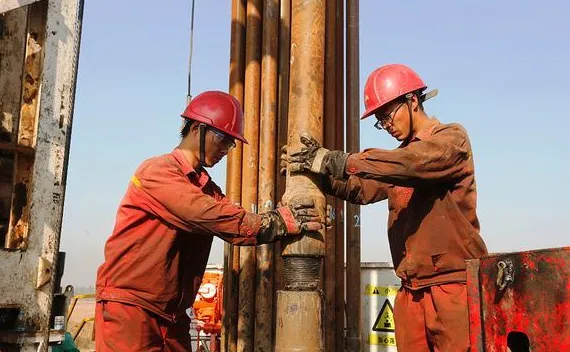What is casing drilling?
Casing drillin
g is a process that uses oil well casing to replace traditional
drill pipes, directly applies torque and drilling pressure to the
drill bit to achieve drill bit rotation and drilling. Unlike conventional drilling methods, this method does not require the use of drill pipes or
drill collars. Instead, the drill bit is salvaged through a wire rope and the drill bit is raised and lowered in the casing. The drill bit and drilling tools can be replaced without drilling. This method reduces the operation of drilling and significantly reduces the occurrence of accidents such as blowouts and stuck drills, improves the safety of drilling operations, and reduces costs.
As early as the 1950s, people envisioned using oil well casing to replace drill pipes to complete drilling, but due to the limitations of technology and equipment at the time, this concept was difficult to achieve. In the 1990s, with the rapid development of new technologies, new materials and electronic technologies, oil and gas drilling technology ushered in great progress, and casing drilling technology once again entered people's field of vision.
The main purpose of casing drilling (CwD) or casing while drilling is to eliminate the traditional casing installation step during the drilling process and to isolate the formation during the drilling process. By using a standard casing string instead of a traditional drill string, drilling and casing installation can be carried out simultaneously in stages.
In addition, casing drilling is also considered an effective risk control method, especially for shallow soft formations where the wellbore is unstable and leakage problems are common. The application of this technology not only improves drilling efficiency, but also provides better safety in complex formation environments.
How do drill pipe and casing work to produce oil and gas?
1. Drilling with drill pipe
The drill pipe is a durable steel pipe that transmits force to the drill bit. In many cases, the drill pipe rotates the drill bit, which cuts into the rock until it reaches the mineral deposit. The last few drill pipes before the drill bit are usually non-magnetic drill collars, especially in horizontal drilling. Drilling with drill pipe is the first stage of every wellbore. At the same time, the drilling mud cools the drill bit and brings the cuttings (i.e. the cut rock) back to the surface.
2. Lining with casing pipe
The outer pipe is called casing pipe. Casing pipe lines the wellbore, thus protecting the soil layer and groundwater from contamination by drilling mud and/or fracturing fluids. It also stabilizes the wellbore, so casing must be able to withstand particularly high loads. Drilling and casing are performed alternately - the drill string is withdrawn at specific intervals, and the wellbore is lined with casing and secured with cement. Then drilling continues.
3. Oil production with tubing pipe
Oil tubing transports oil and gas from the bottom of the well to the surface - this is the third stage of the wellbore. Oil and gas sometimes rise to the surface on their own; usually a pump is needed to bring the fluid to the surface.
The diameter of tubing is naturally smaller than that of casing, except for the 4 1/2-inch diameter. The outer diameter of 114.3 mm (4 1/2 inches) is considered a threshold that can be either casing or tubing. Anything smaller than this size is called tubing, and anything larger is called casing.
From the surface to the bottom of the well, the size of the casing keeps decreasing - there are many types of casing depending on its use and diameter. The "starting point" is where the wellbore gradually transitions from vertical to horizontal. Due to horizontal drilling, the ore deposit can be reached in a more targeted manner. Finally, the drill string is removed and the production casing is inserted into the wellbore and fixed in place. The well is then fractured and the tubing is installed in the production casing.
Features of casing drilling
Casing drilling has obvious advantages over conventional drill pipe drilling. It is a technological revolution in drilling engineering and can bring huge economic benefits to oilfield operators. Casing drilling has the following characteristics:
(1) Casing drilling uses standard oil well casing, and drilling and casing operations are carried out simultaneously;
(2) A bottom hole assembly is installed at the lower end of the casing string, which can be quickly removed by wire rope through the inside of the casing, and the continuous circulation of mud can be maintained during the removal process;
(3) During the entire drilling process, the casing remains flat to the bottom of the well, improving the well control effect;
(4) The casing is drilled into the formation in only one direction and will not be pulled out again, unless it is confirmed that the bottom of the well is dry after drilling, otherwise the last section of the casing string may have to be pulled out;
(5) Casing drilling can use many existing drilling technologies, such as directional drilling, cementing, logging, coring and well testing;
(6) The main difference between the application of these technologies and the original ones is that they no longer rely on drill pipes, but rely on wire ropes instead of drill bits;
(7) Casing drilling uses standard oil field
casing pipe, the only difference is that the casing pipe coupling or thread needs to be modified to provide the torque required for drilling.






 English
English Español
Español بالعربية
بالعربية











 Phone :
Phone :  Whatsapp :
Whatsapp :  Email :
Email : 


